Istanbul is one of those places where one visit leaves a person longing for more, especially if you’ve created a long list of the best things to do in Istanbul. If you’re planning a trip, a few days aren’t enough. Plan for at least a week. Learn a few words of Turkish, sign up for a food tour, pick up an Istanbulkart, and spend time on both the European and Asian sides of the city. Walk the backstreets, enjoy Turkish food, and soak up the ambience of one of the world’s most vibrant cities.
Table of Contents
- Best things to do in Istanbul
- 1. Grab an Istanbulkart
- 2. Stroll across the Galata Bridge
- 3. Enjoy the Golden Horn from a ferry
- 4. Head up to the Pierre Loti Café
- 5. Take a Bosphorus cruise
- 6. Remain ready to enjoy tea at any time
- 7. Enjoy adhān from the mosque minarets
- 8. Visit a mosque
- 9. Enjoy a bite and a view
- 10. Eat your way around Istanbul
- 11. Participate in a game of backgammon
- 12. Spend a leisurely few hours in the bazaar
- 13. Buy ice-cream from a street vendor
- 14. Don’t miss the Basilica Cistern Museum
- 15. Be mesmerized by the Whirling Dervishes
- 16. Soak up the colours of the ‘Spice Bazaar’
- 17. Visit a traditional hammam (Turkish Bath)
- 18. Enjoy a fish sandwich on the waterfront
- 19. Ride the nostalgic tram
- 20. Visit the Rainbow Stairs
- 21. Pay tribute to the hamals of the past and present
- 22. Take an amazing food tour
- 23. Don’t miss Hagia Sophia
- 24. Look down on Istanbul from the Galata Tower
- 25. Check out the Pudding Shop’s gallery of old photographs
- 26. Admire the riches of Topkapı Palace
- 27. Marvel at the opulence of Dolmabahçe Palace
- 28. Wander through Kumkapı down to the waterfront
- 29. Find peace and quiet on the Princes Islands
- 30. Admire Haydarpaşa, a popular Istanbul symbol
- 31. Enjoy a döner kebab
- 32. Soak up an Istanbul sunset
- 33. Enjoy freshly squeezed pomegranate juice
- 34. Pause to people watch
- 35. Go shopping
Best things to do in Istanbul
It’s by no means a comprehensive list but these 35 ideas will help you get started.
1. Grab an Istanbulkart
Moving around Istanbul is easy with an Istanbulkart. The reloadable card can be used on all public transportation, including the historic and modern funicular, tram, historic tram, Metro, ferry, bus, and cable car. The card costs 50TL (2.70 USD) and can be loaded with various amounts at yellow vending machines at ferry, tram, and metro stops. All trips cost cost the same: 7.67TL (0.41 USD), with each connection within a two-hour period being progressively cheaper.
Travel on the Marmaray, a rail line that uses the underwater railway tunnel under the Bosphorus, costs a little more. If you’re arriving at the Istanbul Atatürk Airport (IST), you can pick up an Istanbulkart at one of the vending machines at the airport metro station. The metro is one of several ways to travel from the airport to the city centre and various neighbourhoods.

2. Stroll across the Galata Bridge
The Galata Bridge spans the Golden Horn, connecting Istanbul’s two European neighbourhoods of Eminönü and Karaköy.
The bridge’s most enduring image is its lines of shoulder-to-shoulder fishermen in numbers averaging two hundred a day. The almost unbroken line of bobbing rods contributes to interesting photographs against the backdrop of Istanbul’s characteristic skyline. Dotted along the bridge at strategic intervals are stalls selling fishing rods, wooden rod stands, lines, sinkers, hooks, lures, and bait. Just after sunrise, it’s possible to stumble across fires built in tin cans to take the edge off a crisp winter’s morning. Don’t be surprised if you receive an invitation to share a sample of grilled fish being cooked up for breakfast.
3. Enjoy the Golden Horn from a ferry
Take the public ferry operated by Şehir Hatları up the Golden Horn (Haliç) to Eyüp from Karaköy (or Üsküdar on the Asian side). The ferry zigzags its way up and down the waterway, stopping at Kasımpaşa, Fener, Balat, Hasköy, Ayvansaray, Sütlüce, and the destination, Eyüpsultan.

Ferries operate on a regular schedule, so it’s possible to get on and off to explore the area around each stop. Visit the Rahmi M. Koç Transportation Museum at Hasköy, or wander the streets of the former Jewish neighbourhood of Balat to admire the brightly painted houses. In Eyüp, visit Eyüp Sultan Mosque, Istanbul’s oldest and most sacred mosque and third holiest site in the world for Muslims after Mecca and Jerusalem. From there, walk in the footsteps of the French poet, Pierre Loti up Loti Hill, or take the cable car up to the café for an expansive view of the Golden Horn.
4. Head up to the Pierre Loti Café
There are many places from which to enjoy the fabulous views of Istanbul. The Pierre Loti Café not only offers a superb view of the Golden Horn but reaching it by cable car, covered by the Istanbulkart, is part of the appeal. This was one of the favoured locations of the famous French novelist, Pierre Loti. The easiest way to get there from downtown Istanbul is to take the ferry from Karaköy to Eyüp, a 35-minute journey. Ferries dock right by the Eyüp Sultan Mosque, from where it’s a five-minute walk to the cable car. After admiring the view from the observation deck, visit the small museum dedicated to Pierre Loti, and walk around the hilltop Eyüp Cemetery, where Ottoman-era sultans and writers such as Mehmed Celebi and Mahmud Aga are buried.
5. Take a Bosphorus cruise
Istanbul straddles the Bosphorus, a body of water separating Europe and Asia. It’s actually a strait, about 30 kilometres / 17 miles long. It connects the Black Sea to the Sea of Marmara which joins the Mediterranean. Being the world’s narrowest strait used for international navigation, there’s plenty to observe as the ferry zigzags its way towards the Black Sea.
Avoid the ticket sellers on the Eminönü waterfront. Choose the public Long Bosphorus Tour operated by Şehir Hatları, Istanbul’s public ferry company. It’s such an interesting and relaxing day that I’ve taken this same cruise on visits to Istanbul in the months of September and February. On each trip, I sat on the left side (European side) heading up the Bosphorus and switched to the Asian side on the way back.
The return trip is reasonably priced at 65 TL (3.50 USD). It leaves at 10:35 from the Bogaz iskelesi (Bosphorus Cruises Pier) adjacent to the Galata Bridge at Eminönü. The ferry makes five stops as it goes back and forth across the strait and stops for almost two and a half hours at the quaint fishing village of Anadolu Kavağı, the last port before the Black Sea.
Stroll through the village and enjoy a seafood lunch at one of the many restaurants vying for patrons. It’s also possible to hike up to Yoros Castle with stunning views of the Black Sea and the Bosphorus. Or, browse a few souvenir shops with prices that seemed to be a little cheaper than those in Istanbul. The ferry leaves Anadolu Kavağı at 15:00 and arrives back in Eminönü at 16:25.
6. Remain ready to enjoy tea at any time
Türkiye has a tea culture ‘steeped’ in hundreds of years of tradition. It’s consumed all day long, and considered a gesture of hospitality and friendship when offered to a guest. I was surprised to learn that Türkiye grows as much as ten percent of the world’s tea production, and the homegrown varieties are almost exclusively consumed within Türkiye.
While I enjoyed apple tea when staying at hotels and hostels, it’s considered a beverage for tourists. Traditional Turkish tea is black, served in a small, curved see-through glass on a saucer with a couple of sugar cubes on the side. I was constantly offered tea by hoteliers, restaurateurs, and merchants, and I found myself choosing to enjoy a glass of tea when stumbling across some aspect of Istanbul requiring pause for reflection. Tea became the impetus to make space for enjoying the moment.
7. Enjoy adhān from the mosque minarets
With over 3,000 mosques in Istanbul, chances are you’ll always be within earshot of the adhān, the call to prayer sung five times each day. The exact times change from day to day and place to place, influenced by longitude and latitude, sunrise and sunset, and geographical relationship to Mecca.
I tend to wake up early and found myself looking forward to hearing the hauntingly beautiful reminder that religion governs life in Istanbul. To the residents of Istanbul, of whom 99 percent are Muslim, the adhān is a melodic and spiritual start to the day. To visitors, it’s a reminder of the layers of diverse faiths in the historically tolerant melting pot that is Istanbul.
On one morning, my alarm clock was the call to Fajr prayer around 5:00 am. It was a day when I had planned to catch early morning views of Hagia Sophia and Sultanahmet Camii (Blue Mosque). On another day, it was my signal to head to Eminönü to wander across the Galata Bridge to observe and interact with the fishermen on a misty February morning.
For those who prefer to not have their early morning sleep interrupted in this way, pack some earplugs. After all, there will be other times during the day to enjoy adhān from the mosque minarets.
8. Visit a mosque
The guardians of Istanbul’s magnificent mosques are to be applauded for their efforts in balancing the rights of worshippers, and the curiosity and enlightenment of visitors.
The larger mosques are usually open continuously every day. Visitors are welcome and admission is free, although donations for mosque upkeep are gratefully accepted. To avoid distracting worshippers, visitors might be restricted to the periphery behind a wooden railing.
If the mosque is busy with worshippers, it’s polite to return later. This is especially true on Fridays from late morning through early afternoon, when the weekly group prayers and sermons take place. It’s also a sign of respect to avoid visiting a mosque at prayer time, or within the half hour after the call to prayer is sung from the minarets. To help with your planning, precise prayer times are available online.
Wear modest, conservative clothing exposing a minimum of flesh. For men, this means covering the knees and shoulders and for women, the knees, arms, and head. Therefore, shorts or sleeveless shirts should be avoided on the days when visiting mosques. At many mosques in Istanbul, attendants often provide robes to visitors whose sightseeing clothing is too informal. Carry a pashmina, or incorporate a trip to a bazaar to pick up a beautifully woven reminder of your visit to Istanbul.
In addition, all visitors must remove their shoes before entering. This is a practical, not a religious requirement. Worshippers kneel and touch their heads to the carpet as they pray. There will be a place to store shoes, but be prepared with a means to carry your shoes if that is your preference.
What’s the best mosque to visit in Istanbul? I’m partial to the Sülemaniye, perched majestically on one of the city’s seven hills. Most tourists flock to Camii Sultanahmet (Blue Mosque). With its cascading domes, slender minarets, and blue-tiled interior, it’s very photogenic but very crowded. A unique aspect of the Sülemaniye is that many of its original külliye (mosque complex) buildings have been retained and adapted and repurposed, so it’s possible to spend hours exploring the surroundings without the crowds typically found in the Sultanahmet neighbourhood.
Another favourite is Rüstem Pasha Mosque, and like the Sülemaniye, is another of Mimar Sinan’s architectural treasures. Opened in 1563, it’s regarded as having the best samples of İznik tiles in Istanbul. Some describe it as the Blue Mosque without the crowds. It’s smaller and not as easy to find as the Süleymaniye, but its interior is just as impressive, if not more so.

9. Enjoy a bite and a view
Near Mimar Sinan’s tomb by the Süleymaniye Mosque is the rooftop of the Mimar Sinan Café with exquisite views of the Golden Horn, Bosphorus, and Asian Istanbul.

10. Eat your way around Istanbul
Unquestionably, one of the highlights of Istanbul is the food. One of the ways to experience Istanbul’s culinary delights is to graze your way around the city — a little here and a little there, without necessarily sitting down for an entire meal.
On one of my visits in winter, my early morning starts inevitably led to a waterfront simit cart for a quick energy boost. A simit is a lightly sweetened, savoury crusty bread with a pronounced sesame flavour. It costs 5 TL (0.27 USD). This was followed by a bowl of delicious lentil soup with crusty Turkish bread and the customary glass of tea. Before lunch it’s possible to ‘squeeze’ in a cup of freshly squeezed pomegranate juice and some freshly roasted chestnuts from a street vendor. This type of menu resulted in a total cost of not much more than the equivalent of USD 5.
For supper, try munching your way through different courses at three or four different restaurants. One evening, I enjoyed an appetizer of Turkish pide, moved on to a lokantasi for the main dish, and finished at a pastry shop for Turkish delicacies and coffee.
11. Participate in a game of backgammon
Traditional Turkish teahouses are predominantly the domain of men. They sit at tables quietly sipping tea, sharing conversation, or playing backgammon. More often than not, women don’t go to such places, and there’s an expectation they don’t. In 2011, I travelled with a woman friend and this was fine by us. We weren’t in Canada, and we figured respecting these kinds of cultural norms was the thing to do, however alien they felt. So, we learned to scan the patrons first, and if we didn’t see any women, we either asked if it was appropriate to enter or we looked elsewhere.
Needless to say, the inside of a teahouse isn’t the only place to participate in a lively game of backgammon. Cruising the back streets would inevitably reveal a group of men playing backgammon outdoors. On one occasion, moving closer to observe the action resulted in an invitation to occupy a stool purposely vacated by one of the players. Backgammon skills were optional, as there were plenty of willing spectators whose role seemed to be to see my friend emerge the winner, and the loser the recipient of playful ribbing.
12. Spend a leisurely few hours in the bazaar
Dating from the 1460s, Kapalıçarşı (Grand Bazaar) is one of the oldest and largest covered bazaars in the world.
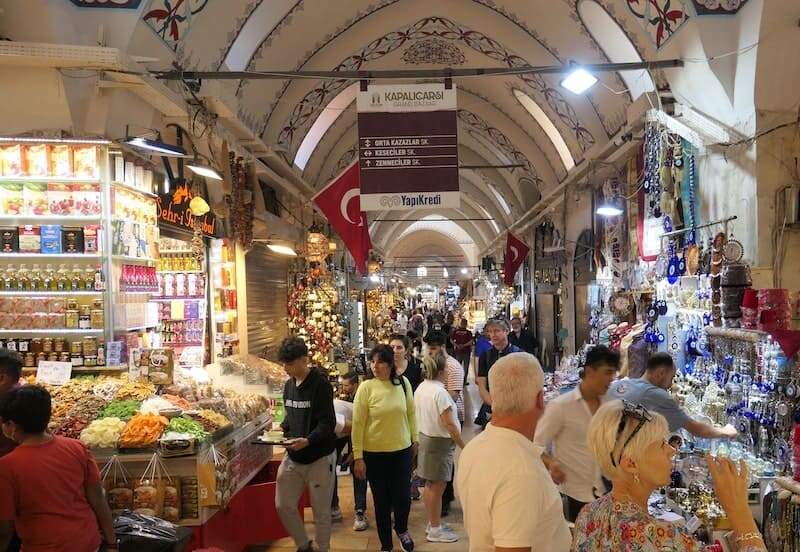
Carpet salesmen seem to be the most persistent and skilled at enticing potential customers into their shops. Making it abundantly clear we weren’t in the market for rugs would invariably invite a change in strategy. Efforts then switched to convincing us to go inside where we were presented with a well rehearsed and informative pitch designed to convert us into customers. The first order of business involved offering the customary glass of çay (tea) or furnishing us with a beverage of choice. Then, salesmen seemed to have all the time and patience in the world to share their immense knowledge of the handsome handmade carpets and rugs for which Türkiye is famous.
If one or more members of your group is in the market for souvenirs, bargaining is part of the experience. It’s the stuff of fond memories savoured long after returning home. For an excellent primer on this age-old tradition, check out How to bargain and get the best prices when traveling.
If you’re in the mood for a bite, I can heartily recommend stopping by Aynen Dürüm at the edge of the Grand Bazaar (Muhafazacilar Sokak No: 33) in a busy and noisy alleyway. Pull up a seat at a small outdoor counter and enjoy a delicious Adana kebab prepared with spices from the Turkish city of Adana. Self-serve garnishing options such as crunchy pickles, roasted peppers, and fresh parsley provide tasty complements.
13. Buy ice-cream from a street vendor
Buying ice-cream in Türkiye is as much entertainment as it is about acquiring a delicious treat. Turkish ice-cream differs from what’s typically available elsewhere. It’s creamy, stretchy, chewy, and sweet. The stretchy texture is attributed to salep, the starchy root of wild orchids.
Look for ‘dondurma’ prominently displayed on a vendor’s stand. Vendors are usually dressed in a red fez, white shirt, and red waistcoat. They use a stirring paddle to entertain customers and a long serving stick to tease and torment them with sleight-of-hand tricks such as flipping cones upside down, snatching cones from the hands of unsuspecting customers, or faking the dropping of ice-cream into a pocket or purse.
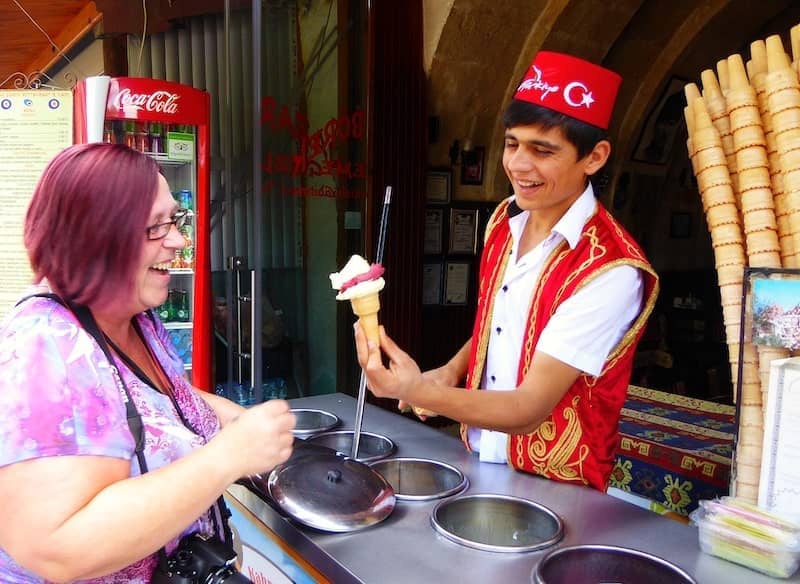
14. Don’t miss the Basilica Cistern Museum
Built in 532, the Basilica Cistern (Yerebatan Sarnıcı) is the largest of several hundred ancient water reservoirs beneath the city. Marvel at the engineering prowess of the designers of this cathedral-sized subterranean chamber that once held 100,000 tons of water to supply Byzantine palaces and nearby residents, delivered through nearly 20 kilometres of aqueducts. Historical texts claim that 7,000 slaves were involved in its construction.
Eventually closed, it faded from living memory until 1545 when a scholar researching Byzantine antiquities was told by residents that they could obtain water by lowering buckets through their basement floors. Some were even catching fish. Eventually, a way was found to access the cistern that had become a dumping ground for all kinds of garbage, including corpses.
Today, the cistern contains very little water, and walkways allow visitors to admire the hauntingly lit sixth-century columns and vaulted ceilings constructed of materials recovered from ruined buildings. The architectural masterpiece has been restored several times, the latest a five-year effort ending in 2022. It included strategies to strengthed its resistance to earthquake damage, and I noticed the addition of several sculptures and the removal of the onsite café. Also, it was pleasing to see a new separate entrance from the exit that has improved traffic flow.

15. Be mesmerized by the Whirling Dervishes
It may feel like a performance, but it’s actually a religious ceremony. There are several venues in Istanbul to witness the remarkable Sufi Whirling Dervishes taking part in unique spiritual rituals rooted in 800 years of tradition.
 Photo credit: Klimkin, Pixabay
Photo credit: Klimkin, Pixabay
16. Soak up the colours of the ‘Spice Bazaar’
Misir Çarsisi, also known as Egyptian Bazaar or Spice Bazaar, is a covered market built in 1660. Constructed as part of the Yeni Camii (New Mosque) complex so its revenues could support the upkeep of the mosque and its school and hospital, the market is named for the exotic spices and essential grains brought into the city from Egypt. Inside is an irresistible collection of sights, sounds, and smells from dozens of stalls selling tea, sweet Turkish pastries, and spices arranged in colourful mounds. It’s touristy, but for a more authentic taste of Istanbul, wander through the adjacent streets featuring a variety of vendors.

17. Visit a traditional hammam (Turkish Bath)
Skip the hotel spa with its facilities and services designed for tourists. Experience the ritual that has endured for hundreds of years in a traditional hammam. We chose Çemberlitaş Hamamı built in 1584, designed by Mimar Sinan, Türkiye’s legendary imperial architect. He left behind a rich legacy of magnificent buildings, and the Çemberlitaş Hamamı, and its services, did not disappoint.
I visited with two women friends; we opted for the traditional style service that involved an intense 15-minute wash, scrub, and massage from an attendant. Our kits contained a peştemal towel, scrubbing mitt, and knickers.

After changing and securing our belongings, we were directed to a raised marble platform, or göbektaşı, large enough to accommodate several clients. Like me, my friends, and other women, my female attendant was clothed in panties. During the rigorous treatment, I wondered how many people over the centuries had experienced the wonders of a hammam, on that very platform. The architecture was impressive, but enjoying it was only possible after the rigorous treatment. We were invited to spend as much time as we wished in the bathing area, and in a resting area after the treatment. What an experience. We left feeling very clean, and as shiny as newly born piglets.
18. Enjoy a fish sandwich on the waterfront
Enjoying balık ekmek (fish sandwich) on the Eminönü waterfront is one of those quintessential Istanbul experiences dating back to a time when fishermen sold freshly caught cooked fish directly from their boats. Today, the practice is regulated and three balık ekmek boats are licensed to carry on the tradition from the Golden Horn side of the Galata Bridge in the shadow of the Sülemaniye mosque.
Business is brisk, and workers in Ottoman-inspired uniforms run an efficient assembly line. Mackerel is grilled on the boat, stuffed into a crusty half loaf with shredded lettuce and sliced onion, and handed to a server on shore. In front of all three boats, customers sit on low stools at tiny tables stocked with salt and lemon juice dispensers.
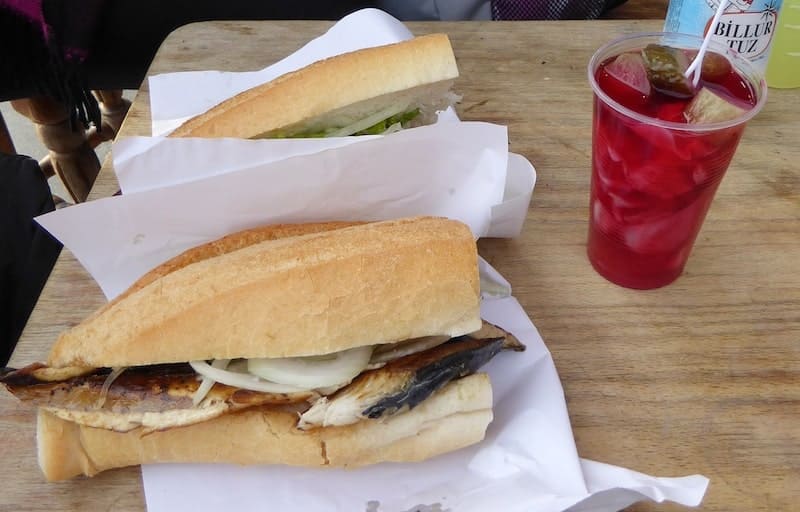
Sold by the balık ekmek vendors from colourful carts nearby, turşu suyu (pickle juice) is a potent companion drink. Credited with medicinal properties, the neon-red mixture containing pickled cucumber and cabbage packs quite the punch as both a sour and salty complement to the fishy taste of the mackerel. Give it a try!
19. Ride the nostalgic tram
Istanbul’s famous İstiklal Caddesi (Independence Avenue) is a busy pedestrian street stretching 1.4 km / 0.87 mi from Taksim Square to Tünel. The Beyoğlu Nostalgic Tram is a restored trolley from the early 20th century, plying the route between Taksim and Tünel, with frequency about every 20 minutes. A popular symbol of the İstiklal Caddesi, the tram slowly rattles and clanks its way along the avenue to the sound of the conductor’s bell warning passengers out of its path. Its progress is slow enough for hitchhikers to jump into the back to grab a quick ride. Otherwise, the fare is covered with an Istanbulkart.

From Taksim Square, connections can be made to the Metro (M2) or the Kabataş -Taksim Funicular (F1). At the Tünel terminus, it’s possible to take the 19th century two-station underground funicular to Karaköy (Old Galata) and the Galata Bridge.
20. Visit the Rainbow Stairs
There are many rainbow stairs, but the ones that garnered public attention are on Salı Pazarı Yokuşu between the T1 tram stops of Findikli and Tophane. In fact, between both stops are three sets of painted steps.
In 2013, retired engineer Hüseyin Çetinel spent four days painting almost 200 steps in a simple act designed to brighten his neighbourhood. He became an overnight sensation a few days later when the steps were returned to their drab grey colour by a misguided municipality that presumably saw it as a rebellious act driven by a social and political agenda. Public outrage was swift and effective. Pictures of before and after the municipality’s intervention went viral on social media. When people across the country started painting steps in rich rainbow colours, the municipality acquiesced and returned the ‘Rainbow Stairs’ to the resplendent colours of Hüseyin Çetinel’s vision.
Today, they stand as a symbol of public protests during a turbulent period in Turkey’s recent political history. For my detailed description, see Istanbul’s Rainbow Stairs.
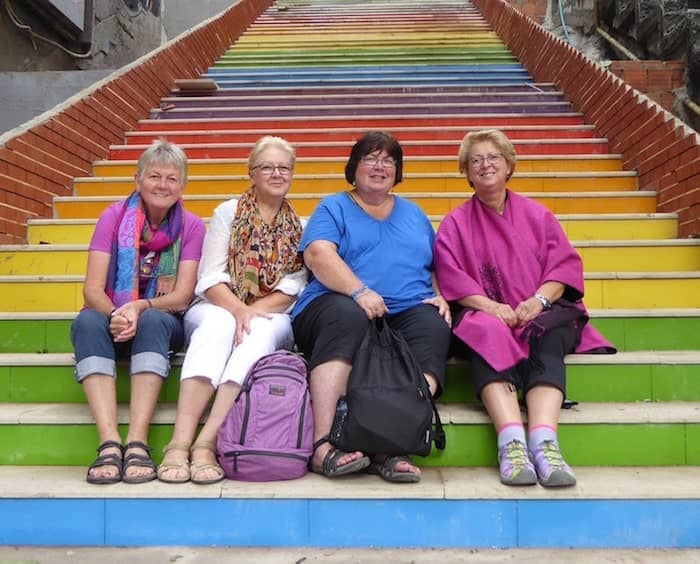
21. Pay tribute to the hamals of the past and present
Wander through Istanbul’s Fatih district, dodging delivery trucks and carts carrying an endless assortment of wares. On a pedestal bordering an alleyway stacked with boxes and crates stands a larger-than-life bronze statue of a humble hamal, representing the hardworking porters of the past. It’s at 51 Âşir Efendi Caddesi, a block from the Hobyar Mosque.
On my first visit to Istanbul in the early 1970s, I was intrigued by these human beasts of burden, amazed at the sight of what seemed impossible for any one person to carry. Their stubby, padded backpacks were stacked high with a variety of cargo, from crates of chickens to giant pianos. Bent over under loads of all shapes and sizes, often with legs barely visible, they moved at a steady pace. The porters of today use carts to move mountainous amounts of cargo.

22. Take an amazing food tour
The best food tour I’ve even taken is the ‘Two Markets, Two Continents’ tour by Culinary Backstreets. I’ve never experienced so many food stops on a food tour. It started with two breakfasts in Europe in the working-class district of Karaköy and moved to the bustling neighbourhood of Kadıköy on the Asian side. Between market stalls, shops, food carts, restaurants, and various eateries, we sampled some of the best food Türkiye has to offer and learned so much about the Turkish food scene along the way. For a detailed description, see Istanbul’s ‘Two Markets Two Continents’ food tour by Culinary Backstreets: A Review.

23. Don’t miss Hagia Sophia
Built as a church, converted into a mosque, transformed into a secular museum, and converted again to a mosque, the magnificent Hagia Sophia (Church of Divine Wisdom, Ayasofya in Turkish) reflects Istanbul’s colourful history. It’s widely regarded as the greatest monument in a city spanning two continents and two historic cultures.

The design of Hagia Sophia was so unique, it was reputed to have changed the history of architecture. For almost one thousand years, it was the largest cathedral in the world before serving as the principal mosque of Istanbul for almost half a millennium. While it wasn’t built as a mosque, it was widely admired in the Islamic world. Its architecture heavily influenced the design of many Ottoman mosques.
I visited Hagia Sophia when it was a museum, spending many hours exploring various parts of the interior. In 2022, my visit lasted not more than 20 minutes. Disappointingly, very little was open to the public, and women were restricted to a small prayer area off to the side. As a result, the long, snaking line to enter Hagia Sophia moves relatively quickly.
Hagia Sophia is closed to visitors during prayer times. Mosques typically close one hour before prayer and open 30 minutes after prayer. As a result of returning to a place of worship in 2020, there’s no longer an entrance fee.
24. Look down on Istanbul from the Galata Tower
Dominating the skyline of Beyoğlu, the Galata Tower offers one of the best viewpoints for an unobstructed 360-degree view of the city. Needless to say, choose a clear day and be cautioned that queues can be long, and the viewing platform can become crowded. Two elevators whisk visitors to the seventh floor. From there, two flights of stairs complete the climb to the observation deck.
25. Check out the Pudding Shop’s gallery of old photographs
The Pudding Shop, located opposite the Sultanahmet Mosque, will interest those who passed through Istanbul on the ‘hippie trail’ in the late 1960s and early 1970s. The hippie trail was the overland route to and from India and beyond. It would end in 1979 when both Iran and Afghanistan became off-limits, the former due to the Islamic Revolution and the latter to foreign invasion by the Soviet Union. When I passed through Istanbul in the early seventies, it was in November, so most were travelling in an easterly direction. Some were bound for Nepal in search of adventure and enlightenment, or the beaches of Goa to experience paradise. Others were interested in scoring hash that was strong, cheap, and readily available. Many others were returning home to Australia or New Zealand.
This was at a time when today’s popular sites of Hagia Sophia, the ‘Blue Mosque,’ and Topkapı Palace were all but deserted. The Pudding Shop, opened by Idris Çolpan and his brother Namik in 1957, was a favourite hangout of travellers on the hippie trail. Posts on its notice board contained advice, mail, messages, and advertisements for lifts and merchandise. Today, photographs from that era adorn the restaurant’s walls.

26. Admire the riches of Topkapı Palace
Topkapı Palace is an immense compound where the Ottoman sultans lived and governed in opulent resplendence for almost four centuries. Initial construction started in 1459 under the direction of Fatih Sultan Mehmet, conqueror of Byzantine Constantinople, in 1453. During the long reign of Sultan Süleyman the Magnificent (1520–66), the empire expanded its borders from Iraq to Tunisia and even to the gates of Vienna. At the height of its existence as a royal residence and seat of government administration, it was home to as many as 10,000 people with mosques, a hospital, bakeries, and a mint.
Topkapı Palace gradually lost its importance at the end of the 17th century, as the Sultans preferred to spend more time in their new palaces along the Bosphorus. After the end of the Ottoman Empire in 1921, Topkapı Palace was converted to a museum in 1924. The innumerable rooms and chambers house lavish costumes, ostentatious furnishings, impressive calligraphy, and jewels from every corner of the empire. It was all designed tooverwhelm visitors with the empire’s immense power and unfathomable wealth. The architecturally magnificent Imperial Harem is an eye-opener, featuring intricate Ottoman tile art and built-in cubicles in the walls shaped to accommodate turbans.
 Photo credit: waldomiguez, Pixabay
Photo credit: waldomiguez, Pixabay
27. Marvel at the opulence of Dolmabahçe Palace
The sumptuous Dolmabahçe Palace is one of the most glamorous palaces in the world, a symbol of the decadence and opulence of the Ottoman era. It was built at a cost of $1.9 billion (at today’s value), home to six Sultans since 1856 and where the founding President of Turkey, Mustafa Kemal Atatürk, died in 1938.

28. Wander through Kumkapı down to the waterfront
Kumkapı is a former Armenian neighbourhood filled with restaurants, some featuring live music. It extends to the waterfront where the Tarihi Kumkapı Balıkçılar Çarşısı, a fish market, supplies fresh seafood to a host of waterside restaurants. Look for a table overlooking the Sea of Marmara, order something off the menu and chances are the raw version will arrive within minutes to be prepared in the restaurant’s kitchen.
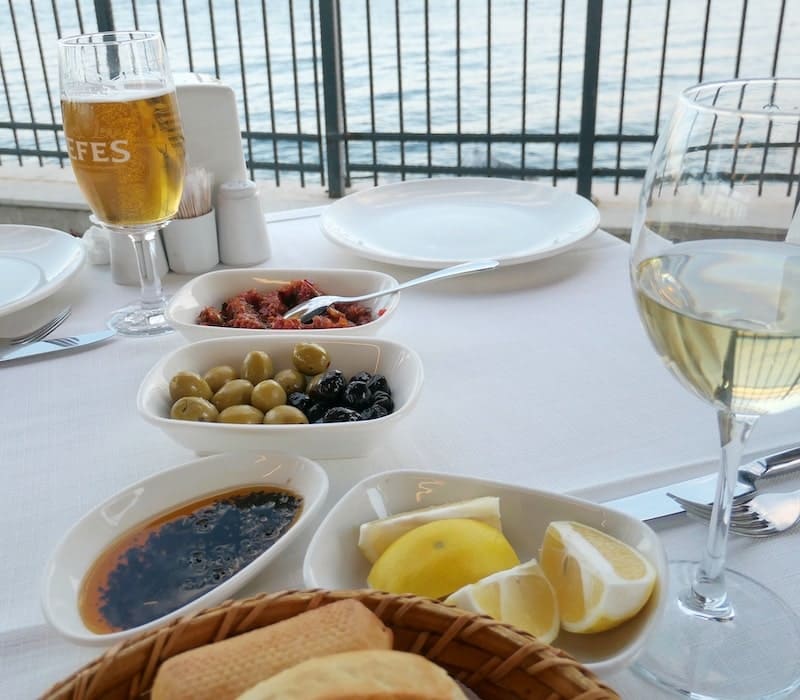
29. Find peace and quiet on the Princes Islands
The Princes Islands, or Adalar (Islands), is an archipelago of nine islands in the Sea of Marmara, an hour or so by ferry from Istanbul. Most ferries stop at the four largest islands. All islands are car-free, with bicycles and electric mopeds as the key modes of transportation. The first stop is at Kınalıada, the second at Heybeliada, then Burgazada, and finally at the largest island, Büyükada.
Choose a weekday if possible. A one-way trip (in 2022) cost just 21.90 TL (1.18 USD) on the Istanbulkart. Catch the ferry from Kabataş or Kadıköy. Get off at one island, wander about, enjoy a seafood lunch at a waterside restaurant, and catch a ferry to the next island an hour later after tapping your Istanbulkart at the ferry terminal.
Where fires, neglect, poor planning, and demolition have destroyed most of Istanbul’s wooden houses from the Ottoman era, many wooden houses remain in the Princes Islands. Several are derelict but still display intricate design elements to be appreciated.
One surprising aspect of my visit to the Princes Islands was the size of Istanbul. As the ferry moved around and between the islands, we were never out of sight of the city that keeps extending its borders, understandable given a population of 15.6 million.

30. Admire Haydarpaşa, a popular Istanbul symbol
Haydarpaşa, the Asian railway terminus next to the Kadıköy wharf, is one of the many grand symbols of Istanbul. It was opened in 1908 to serve the growing demand for train travel between Istanbul and Anatolia. Unfortunately, it was closed after a fire in 2010, and although the stained-glass windows, wall coverings, and engravings in the waiting room have been restored, it remained closed in 2022. In the meantime, despite the scaffolding cover, the building can be admired from ferries serving the Kadıköy wharf and Princes Islands.

31. Enjoy a döner kebab
There’s no shortage of restaurants or stalls where one can enjoy döner kebab. A typical döner kebab has seasoned meat (usually lamb or chicken) stacked vertically around a cone-shaped skewer that slowly rotates around a heat source. Part of the enjoyment is observing the effort that goes into tending the right amount of heat for the seasoned chicken and lamb on a vertical rotisserie. Watch the cook constantly sharpen his knife to cut thin shavings from the outer layers as it cooks. Then, enjoy a döner kebab on a plate or stuffed into a pita or other type of bread or flatbread as a sandwich.
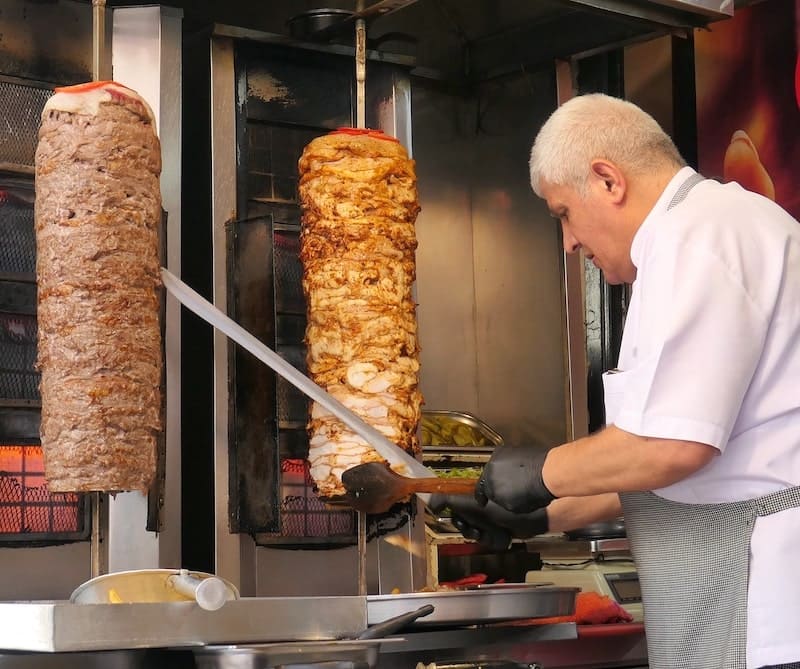
32. Soak up an Istanbul sunset
There are plenty of spots from which to enjoy the Istanbul skyline at sunset. From Üsküdar, watch the sun dip behind the Maiden’s Tower a short distance offshore. Or find a rooftop restaurant or bar and watch the colours unfold in the distance. Or admire the minarets and domes of Istanbul’s mosques bathed in golden hues from one of the commuter ferries.

33. Enjoy freshly squeezed pomegranate juice
In Türkiye, the pomegranate is not just another fruit. It’s not only nutritious and delicious, but the revered pomegranate is a symbol of good fortune. In a country where pomegranate trees have been cultivated since ancient times, it’s a tradition to smash a pomegranate, or “nar,” on the floor at weddings or on New Year’s Eve in the hope that it will bring good fortune. In September and October, enjoy freshly squeezed pomegranate juice for its health and nutritional benefits, its exquisite taste, and who knows, perhaps a dose of good fortune.
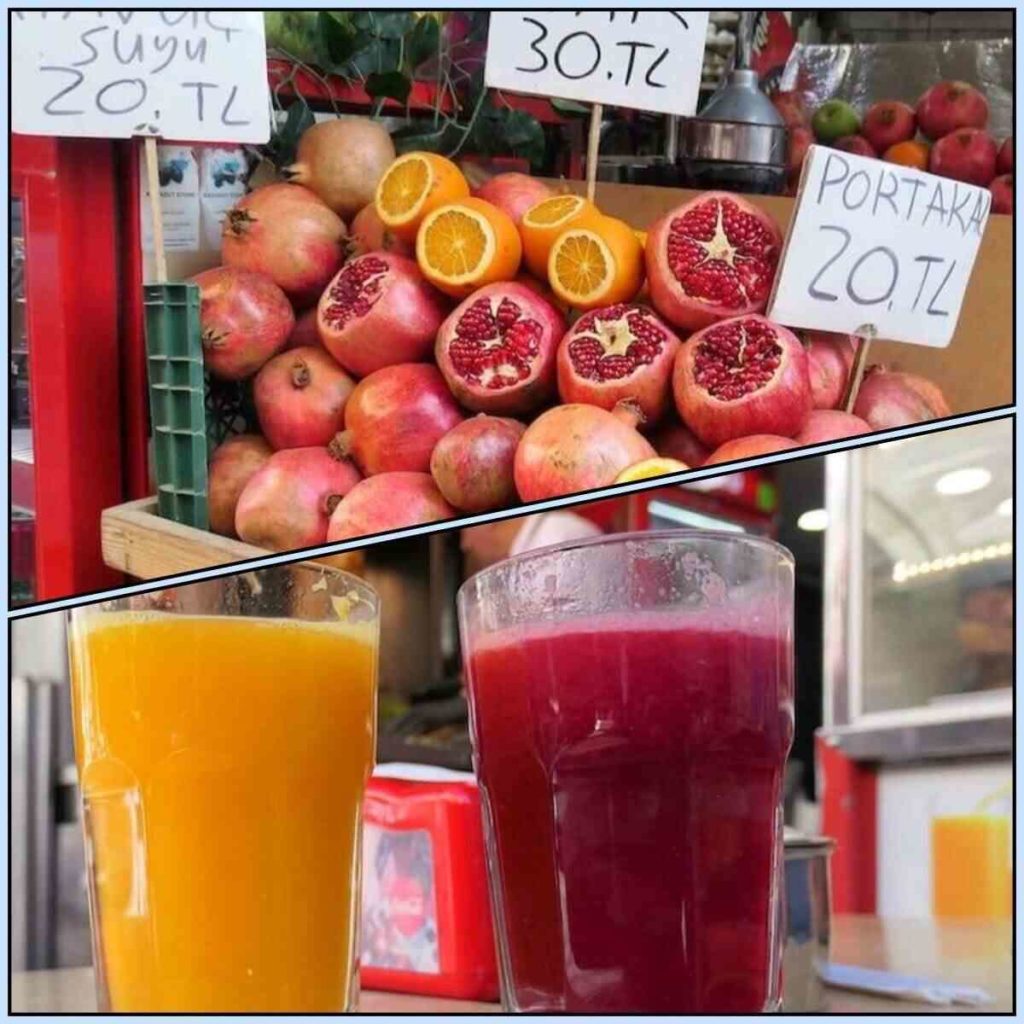
34. Pause to people watch
There are many vantage points from which to soak up the magic of Istanbul, much of it involving people going about their daily activities.
Beside the New Mosque, we stopped to watch a youngster and her brother chase bubbles launched by a merchant selling plastic bubble makers. We couldn’t resist purchasing one of the toys and giving it to the child with the mother’s permission. The sheer enjoyment of watching youngsters at play was enough, but the facial expression of a grateful child was a highlight of the day.

35. Go shopping
For packing light travellers, what’s a small, lightweight, and useful souvenir from Istanbul? I rarely shop for souvenirs when I travel but I’ve succumbed to picking up a few gems that consume very little space in my travel bag. These include a multi-coloured pashmina that goes with any travel outfit, zippered cloth pouches for electronics such as wired earphones and an external charger, and evil-eye jewellery.

These suggestions barely scratch the surface of interesting things to do in Istanbul. The city’s fascinating history, scenic location, delicious food, frenetic markets, world-class museums, and some of the most friendly and hospitable people I’ve ever met make Istanbul one of the most intriguing cities on earth.
If Türkiye is on your travel list, you might find these related posts of interest:
- An amazing two-continent food tour in Istanbul: a review
- What’s the best mosque to visit in Istanbul?
- Explore Istanbul on a budget: get an Istanbulkart
- The fascinating story of Istanbul’s rainbow stairs
- A relaxing blue cruise on a Turkish gulet: Seaborn Legend
- Is ballooning in Cappadocia worth it?
- 7 Reasons to visit Derinkuyu ancient underground city in Türkiye
If you found this post helpful, please share it by selecting one or more social media buttons. Have you been to Istanbul? If so, what have I missed? Please share your thoughts in the comments. Thank you.
Care to pin it for later?
 Photo credit: Osman Bilgin, Pixabay
Photo credit: Osman Bilgin, Pixabay


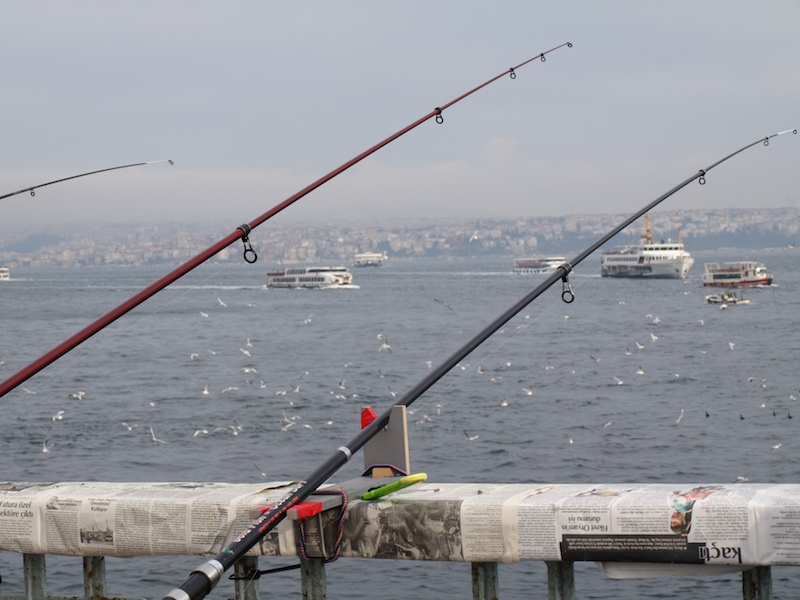




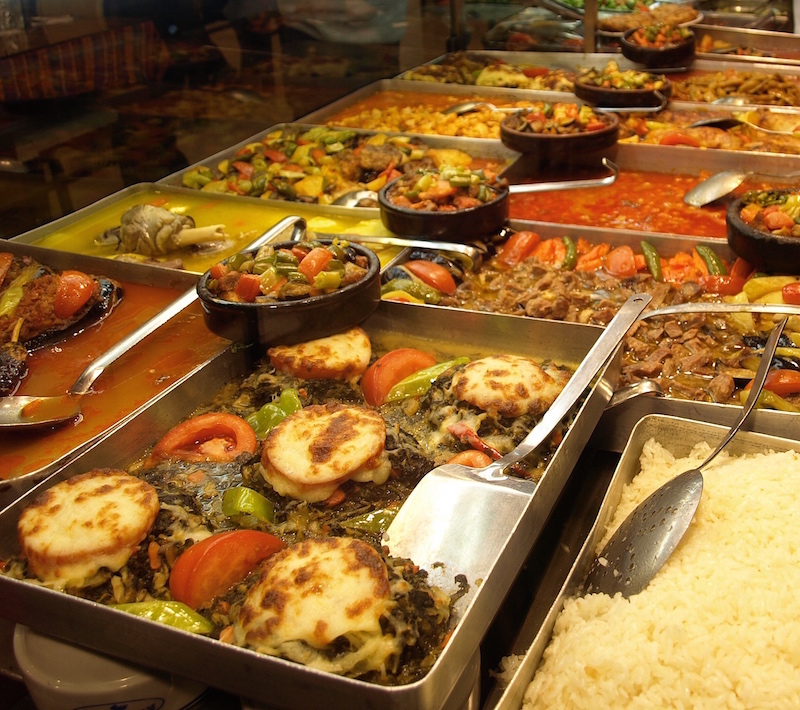






Great post, Anne! It brought back so many wonderful memories of cay sipping and people watching. Loved your backgammon experience! Don’t know how to play myself, but would definitely love to be invited to join in on the fun, even if just to watch it all play out! It’s certainly a place that keeps on drawing you back. Can’t wait to go again!
Great post, thank you!
Also I want to add my favorite spot as a local.
Basilica Cistern (Yerebatan Sarnıcı): This is a very magical underground cistern with dimmed light; there comes a classical music and sound of dripping water. Its a very romantic experience. Its like you find yourself at one of the fairy tales.. You will be in surprised at how this structure was constructed so long ago and how magical it is.
Also I am an Airbnb host, having an apartment located 10 mins walk to Taksim Square. I love meeting people and share my experiences. You can contact me through Airbnb message and ask for any local advices. Lets keep in touch!.
https://www.airbnb.com/rooms/6943257
istanbul is a very beautiful city between asia and european continents
Thanks for sharing such a great post. The foods are like so delicious. Hope to visit Istanbul.
Wow!! it is Nice.This is something Really special . I am interesting , your blog very usefull. keep going.
George Moore recently posted…Colorado Chicken Pizza with Cheesy White Sauce
What a fantastic round-up of things to do in Istanbul! I’ve always wanted to explore the Hagia Sophia and the bustling Grand Bazaar, and your detailed tips are super helpful for first-timers like me. The suggestion to take a Bosphorus cruise as the sun sets sounds absolutely magical. I can’t wait to experience the vibrant culture and history of Istanbul. Thanks for sharing these gems!